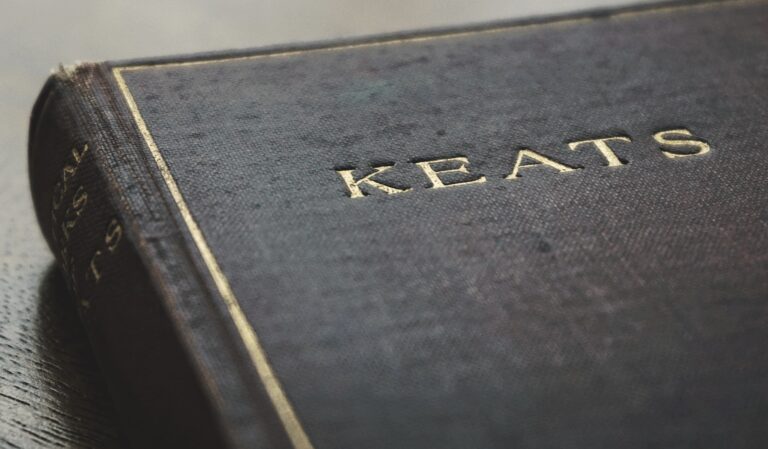A Journey Through Irony in Poetry – Examples and Meanings
Irony is often a tool used to express one’s innermost feelings, thoughts and emotions in their writing. It can be seen as a journey of sorts, through the dark depths of our minds and into realms we never knew existed. Like an explorer setting out on an expedition, writers use irony as a way to explore what lies beneath the surface and discover new meanings hidden within its depths. In this article, I will discuss some examples of how ironic poetry can take us on a journey – from beginning to end – that helps us understand ourselves better than ever before.
We all have stories worth telling; sometimes it just takes the right words for them to come alive. Irony can give those stories more depth, allowing readers to feel connected with something larger than themselves – a story that transcends time and place but still speaks directly to each individual reader’s heart. Through these poetic journeys of understanding, readers gain insight into their own lives while simultaneously learning about someone else’s experience – both exciting journeys full of potential meaning and emotion. Join me as I explore how irony works in poetry and reveal what it has to say about life experiences around the world today.
Definition Of Irony
Irony is a literary device used to create tension, express surprise and heighten dramatic effect. It’s when words are used to convey the opposite of their literal meaning. The definition of irony in regards to poetry can be found in its use of language. Irony often relies on contrast between what appears to be true or expected, and what actually happens.
In poetic irony, it may appear that the poet is saying one thing but really means something else entirely. For example, a poem might describe an idyllic landscape where birds sing merrily and the sun shines brightly—but if the speaker’s tone suggests disgust or despair, then this would be ironic because it refers to something much different than what was initially described.
Irony also lends itself well to satire–it allows poets to criticize society without seeming too harsh or opinionated. By expressing ideas through irony rather than direct condemnation, they can still make their point while adding humour and wit into the equation. Irony in poetry adds depth and complexity to themes like love, loss and mortality, making them more meaningful for readers as they uncover hidden meanings beneath the surface-level language.
Use Of Irony In Poetry
Irony is a common technique used in poetry to create suspense and evoke emotion. It can be seen when a poet uses words or phrases that have different meanings than what they appear to mean at first glance. For example, verbal irony occurs when the writer says one thing but means another. A great example of this type of irony can be found in Robert Frost’s poem “The Road Not Taken.” In this poem, he talks about two paths diverging in a yellow wood; however, it is clear from the context that he will never actually take either path and instead regrets his choice not to explore more options. Irony can also occur in many poetic terms such as metaphor, simile, personification, and alliteration.
William Wordsworth’s famous example of ironic poetry is found in his work “Daffodils” where he describes seeing daffodils on the lake-shore yet ends with sadness due to their transitory nature – how quickly they are gone after being enjoyed for a short time. This irony creates suspense within the reader who gains an understanding of the discrepancy between joy and sorrow that Wordsworth experiences during his journey through life. Finally, Alfred Lord Tennyson’s use of irony in many of his works serves as an excellent illustration of how irony can be used effectively to convey deeper messages within poetry. Within each line lies hidden meaning which adds depth and complexity to Tennyson’s poems thus contributing greatly to their beauty and power.
Situational Irony
Situational irony is a literary device that occurs when the outcome of a situation or event differs drastically from what was expected. It often involves characters in a story achieving the opposite result to what they were attempting. In poetry, situational irony can be used to create suspense and surprise for readers.
The use of this form of irony can also add an element of humor to poems by defying expectations. An example of situational irony in poetry can be seen in Robert Frost’s “Mending Walls,” where he writes about how walls are built between people yet at the same time it is these very walls that keep them together. This poem highlights an ironic truth: though we build barriers around us, we are still connected through our shared experiences and emotions.
Situational irony in poetic works adds depth and complexity to otherwise simple stories, creating more engaging pieces for readers. By using sarcasm and wit alongside elements of surprise, poets can craft unique narratives that challenge traditional ideas and offer new perspectives on familiar topics.
Verbal Irony
Verbal irony is a powerful tool for poets – it can be used to express feelings of sarcasm, ridicule or even dark humor. It can also be used to cleverly emphasize certain points and draw attention away from others. By its nature, verbal irony often requires the audience to read between the lines in order to understand what’s really being said.
Poets use this technique quite frequently throughout their work as it creates an interesting tension between what’s written and what’s implied. Through carefully chosen words and subtle nuances, they are able to make statements that wouldn’t necessarily convey the same meaning if spoken out loud. For example, by writing “I’m so happy I could just burst into tears” instead of simply saying “I’m very unhappy”, a poet can add layers of complexity and emotion to their piece.
Verbal irony gives readers insight into the thoughts and emotions of characters in poems which would otherwise remain hidden beneath the surface. By providing hints about these inner states through seemingly contradictory language, poets give us glimpses into how they truly feel — allowing us to better connect with them on an emotional level. This forms a bond between writer and reader which helps create more meaningful works of art that inspire readers long after they finish reading.
Dramatic Irony
Having discussed verbal irony, let us now turn our attention to dramatic irony. This type of irony occurs in literature when a character is unaware of their true situation or the consequences that will unfold due to their actions. Here are three key features of dramatic irony:
- The audience knows something which characters in the text do not know
- For example, if a character unknowingly says something that foreshadows an event yet to come
- Or if they make a decision without knowing its ultimate outcome
- Characters act differently than what would be expected by the reader as they remain unaware of important facts and information
- It creates suspense because it increases tension between the expectations of readers and the reality unfolding for characters
Dramatic irony often heightens emotion as readers anticipate that events may take an unexpected twist. Moreover, it can also leave audiences feeling sympathetic towards characters who have unwittingly placed themselves into difficult situations. Despite this sympathy, there is still a sense of anticipation as we wait to see how these characters will respond when they eventually become aware of their predicament. As such, dramatic irony forces readers to actively engage with texts on multiple levels.
Socratic Irony
Socratic irony is a special kind of irony that comes from the teachings of Socrates. It’s an indirect form of communication in which someone deliberately says something contrary to their true beliefs. The purpose of Socratic irony is not to deceive, but rather to bring out the truth through questions and dialogue with others.
It was first used by Socrates as a way to engage his audience in philosophical discussions without having them feel threatened or defensive. He would often ask seemingly simple questions that had complex answers, leading people to think deeply about things they hadn’t considered before. This method allowed him to challenge assumptions and arrive at new understandings based on reasoned argumentation instead of just accepting conventional wisdom or ideas handed down from authority figures.
Socratic irony can still be seen today in many forms such as satire, sarcasm, and even jokes. By using this type of humor, we are able to express ourselves without having to make direct criticisms or judgments on other people’s thoughts or opinions. Ultimately, it serves as a way for us to explore different perspectives while maintaining respect for one another’s views and allowing open-minded debate.
Irony In Literature
Symbolism plays a key role in understanding irony as it relates to literature. Irony is often used by authors to give deeper meaning or insight into the plot, characters and themes of their stories. When used effectively, this literary device can leave readers with an appreciation for what was said between the lines, offering them a unique perspective on the work they’ve read.
Irony occurs when there’s a discrepancy between what’s expected and what actually takes place within the story; situational irony occurs when unexpected events take place that are contrary to how one would normally expect things to unfold, while dramatic irony happens when the reader is aware of something that other characters do not know yet. Shakespeare famously uses both forms of irony in Romeo and Juliet: Romeo kills himself because he believes Juliet has died first, but she actually wakes up just after his death. Similarly Kate Chopin’s main character in The Story of an Hour dies due to shock after learning her husband isn’t dead like she originally thought – again demonstrating dramatic irony at play.
In poetry too, ironic elements can be found everywhere from Edgar Allan Poe’s Annabel Lee (where ‘the angels name her’) to William Blake’s poem ‘The Tyger’ which speaks about God creating such a fierce being despite its beauty. In each case we find sharp incongruity between our expectations and reality – leaving us captivated by the writer’s ability to convey more than meets the eye. All types of irony have become staples in literature today allowing writers of all genres to bring depth to their works through different perspectives offered by these devices.
Frequently Asked Questions
How Does The Use Of Irony In Poetry Differ From Other Forms Of Literature?
The use of irony in poetry differs from other forms of literature in that it often relies heavily on the reader’s ability to interpret and understand subtle hints or metaphors. Irony is a literary device used to express an idea, situation, or emotion in a way that goes beyond what is stated directly. In poetry, this type of expression can be particularly powerful because it allows the writer to explore deeper meanings without having to explicitly state them. The challenge for readers lies in being able to make these connections between words and ideas while still appreciating the beauty of the poem as a whole.
How Can Irony In Poetry Be Used To Convey A Deeper Meaning?
Irony in poetry can be a powerful tool for conveying deeper meaning. It’s often used to contrast the literal surface of a poem with something more complex or contradictory underneath, creating an effect that is both thought-provoking and emotionally engaging. Irony allows poets to express emotions through contradiction, not just straightforward expression; it adds layers of complexity to their work by allowing them to explore ideas from multiple angles simultaneously. By using irony in creative ways, poets can convey subtle messages without explicitly stating them – evoking feelings of joy, sadness, anger, or any other emotion they wish to evoke. Ultimately, irony helps make poems richer and more meaningful than they would otherwise be.
What Are Some Examples Of Irony In Classic Poetry?
Classic poetry is rife with irony, and there are plenty of examples to explore. Take Robert Frost’s ‘The Road Not Taken’, for instance; the poem speaks about a man who decides to take one path in life over another, yet it can be interpreted as a metaphor for regretting decisions we make throughout our lives. Another example is William Wordsworth’s ‘I Wandered Lonely as a Cloud’; despite its seemingly cheerful description of nature, the speaker’s loneliness implies that he prefers his own company to that of others. Finally, Alexander Pope’s ‘An Essay on Criticism’ contains several instances of satire and ridicule directed at writers whose work lacks quality and originality. These works demonstrate how powerful irony can be when used by skilled poets.
What Are Some Of The Most Effective Techniques For Creating Irony In Poetry?
From dramatic understatement to paradoxical statements, irony can be an effective literary device for providing new perspectives and deeper meanings in poetry. To effectively create irony in a poem, the writer should use exaggeration to craft vivid imagery that grabs readers’ attention from the start. The style of Ernest Hemingway is often seen as ideal for creating ironic works – his concise sentences with sharp turns of phrase draw readers into a story without overwhelming them. Ultimately, writing with an engaging tone and avoiding overly complicated language will help convey your message while leaving room for interpretation.
What Are The Benefits Of Using Irony In Poetry?
The use of irony in poetry can be an effective way to express feelings and create powerful imagery. Irony allows poets to communicate their point without being overly direct, making it easier for readers to engage with the poem on a deeper level. It also provides a subtle contrast between what is said versus what is actually meant that encourages the reader to consider alternative interpretations of the text – something especially useful when writing about complex topics or emotions. Finally, irony’s ability to surprise and delight readers makes poems more memorable and enjoyable overall.
Conclusion
I’ve come to realize that irony in poetry is a powerful tool for conveying meanings and creating an impactful message. It can be used to convey deeper truths, emotions, experiences, and feelings. By utilizing techniques such as allusion, metaphor, satire, hyperbole, and allegory poets have the ability to create ironic images with great effect. Irony can also provide readers with insight into social issues or moral dilemmas which may otherwise be difficult to express through traditional language. Ultimately, my journey has taught me that the use of irony allows us to explore ideas more deeply while making our writing more interesting and engaging.




